SAA – Abbreviation for Colt Single Action Army revolver. The SAA,
as collectors, shooters and engravers, call it, has been in production
since its introduction in 1873. Over the course of its production
countless SAA’s have been engraved both at the Colt factory and by
freelance engravers under contract to the factory and individual
owners. The SAA has also been replicated by a number of companies in
Italy and the US. Overall, the SAA probably accounts for more work for
American engravers than any other make and model of firearm.
|
SCALES – The outer handle plates of a folding knife. Scales can
be made of nearly any solid material but when they are made of metal
they may become the subject of the engraver’s art.
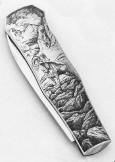
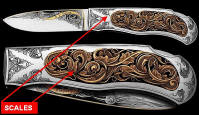
Pictured is a knife made by Steve Hoel and engraved by Steve Lindsay
with a big horn sheep motif and another knife made and engraved by
Steve Lindsay.
|
SCAUPER – British engraver’s term for a flat chisel or graver.
See: FLAT GRAVER.
|
SCENE – A design incorporating more than one figure, sometimes
having a landscape or building in the background and/or foreground.
Also see GAME SCENE,
JAGDSZENEN,
PAESAGGI, SCENE di CACCIA, and
VIGNETTE.
|
SCENE di CACCIA – Italian for game scene. Italian engravers
sometimes refer to paesaggi (literally landscape) for a game scene.
|
SCOPE – See
MICROSCOPE.
|
SCORPER – Archaic American engraver’s term for a flat chisel or
graver. See: FLAT GRAVER.
|
SCRAPER – A hand tool used by engravers to scrape small amounts
of metal while modeling or sculpting a design.
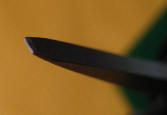
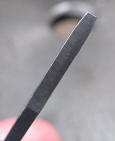
Shown here are pictures of a scraper as made using a Carl Bleile/Lindsay
template.
|
SCRIBER - A tool used by engravers and machinists to scratch a
mark on a hardened surface. The scriber resembles a steel pencil and
has a needle-like point. Also known as a “scratch awl.”



Pictured are examples of three different scribers as used by engravers
and other craftsmen.
|
SCRIMSHANDER – One who scrimshaws.
|
SCRIMSHAW – Scratching or cutting a shallow design into horn,
bone, ivory, or a synthetic representing the aforementioned. Scrimshaw
is done in a style that resembles line, banknote, or bulino style
engraving on metal.
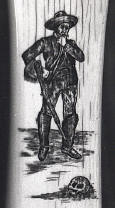
Pictured is a magnification of a Bowie knife handle scrimshawed in the
1970's by Carl B. Bleile of Cincinnati.
|
SCRIPT - The script letter group includes script letters,
cursive letters, and swash letters. Each letter style has its
foundation in handwriting. Letters in the script letter grouping are
not used as all caps. Script letters, composed of thick and thin
strokes, have hairlines connecting one letter to another. These
hairlines are also called kerns. Kerns connect letters allowing the
letters to flow into words. Script letters may be basic or formal.
Basic script retains the curvilinear letterform without thick and thin
variations of stroke. The strokes of formal script letters have thick
main stems and thin connectors. Script letters give the impression of
elegance, dignity, and refinement suitable for announcements,
inscriptions, or invitations.
Script lettering is one of the most common types of lettering executed
by hand engravers the others being Blackletter, Gothic, Old English,
and Roman.
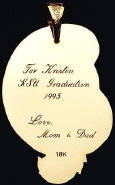
Pictured is a hand lettered script inscription by Steve Lindsay.
|
SCROLL – A spiral form in ornamental design derived from the
curves of a loosely rolled parchment scroll. This is the most widely
used and varied type of decoration traditionally engraved into
firearms, edged weapons, jewelry, silverware, armor, and heraldic
insignia. Scrollwork falls into several design categories, the names of
which vary from one country’s engravers to the next.
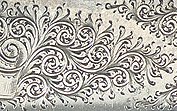

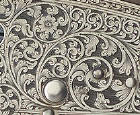
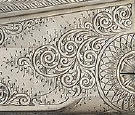
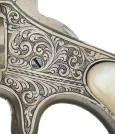
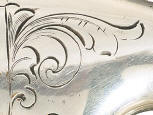
Pictured are a variety of scroll engravings by various craftsmen
|
SCROLL BANNER – A trade name or owner’s name engraved inside a
curving banner and engraved with scrollwork on the ends.



|
SERIF – The tips engraved at the ends of stems and bars of Roman
letters.
|
SETTING PUNCH - A hand punch used to set precious metal inlays
in place. A setting punch is usually made of brass.
|
SHADE CUTS – In script lettering, the wide cuts as compared to
hairlines. In block lettering, the cut used to shade a filled in
letter.
|
SHADING – A term used by hand engravers that describe the
hatching and/or cross-hatching of the elements of an ornamental design
such as scrollwork. Shading is one of three basic tasks in the
engraving of ornamental designs. These three are: outlining, shading,
and backgrounding. There are styles of engraved ornamentation that omit
either backgrounding and/or shading. For instance sculpted relief
ornament is not shaded as shading is only a substitute for actual
relief. Flare cut scroll requires neither shading nor backgrounding as
the beveled outlining cuts create a relief appearance that contrasts
with a plain background.

|
SHARPENING – The grinding, shaping and polishing of a graver.
Correct sharpening can include: face or rake angle, heel, belly or
relieving facets. Also known as “whetting” or “whetting-up.”
|
SHARPENING FIXTURE – A device used in conjunction with a power
hone for shaping and sharpening gravers to exact, repeatable angles.
Sharpening fixtures may be found in both standard and dual angle
configurations. GRS manufactures the most popular line of sharpening
fixtures used by engravers, jewelers, and stone setters.
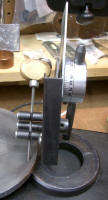
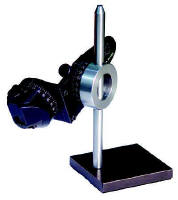
Pictured are single angle and double angle sharpening fixtures.
|
SHARPEING TEMPLATE – A polycarbonate plate of various
configurations having a central hole for insertion of a graver holding
clamp, which allows for consistent and repeatable graver sharpening.
Sharpening templates may be used in conjunction with a power hone,
bench stones, or a drill press mandrel for shaping and sharpening
gravers. Sharpening templates are manufactured by Steve Lindsay Tools
and Engraving of Kearney, Nebraska and have been designed by a number
of well known toolmakers and engravers.
http://www.handgravers.com/sharpenin...rallel%20Point
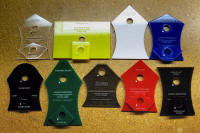
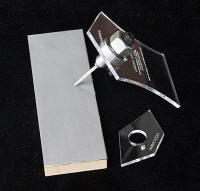
Pictured are a variety of sharpening templates and a univresal template
with a graver in position for sharpening on a bench stone.
|
SIDE HAND METHOD – A technique of engraving with hammer and
chisel. Most H&C engravers in Europe and the USA use the European or
“side hand” technique. In the side hand method the engraver holds the
chasing hammer in the strong hand and the chisel in the weak hand with
the palm down with the pointed end of the chisel projecting from the
heel of the hand and the butt of the chisel handle projecting from the
encircling thumb and forefinger. The engraver thus cuts away from his
or her body with the shaft of the chisel roughly parallel with the
forearm. The side hand method can be contrasted with the Asian method
where the engraver cuts with the point of the graver pointed toward
himself and the palm up.
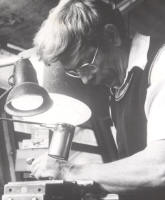

Pictured left is the late Frank Hendricks of San Antonio, Texas
engraving in the "side hand" or "European" method. At right is the late
Floyd Warren of Courtland, Ohio with hammer and chisel engraving "side
hand."
|
SIDE LOCK – The action mechanism of a firearm assembled on two
separate plates and subsequently placed into opposite sides of a gun
behind the body of the breech. Common to high-grade double guns, the
external portion of the side lock is often the subject of engraved
decoration and thus becomes a focal point of the gun. Also known as a
“lock plate” especially when referring to those fitted with external
hammers.



Pictured examples of side locks are an L. C. Smith (USA), Gebruder
Merkel (Germany), and J. P. Clabrough (England).
|
SIDEPLATE – Usually made of brass or German silver, on muzzle
loading firearms, the sideplate is inlayed into the gunstock opposite
the lock plate and has a hole through which passes the main lock plate
fastening screw. On higher quality arms, the side plate is often
engraved with a decorative motif.
Sideplates are also found on some repeating arms such as Winchester
models 1866 and 1873 and Colt and Smith & Wesson double action
revolvers. In those cases the sideplate protects and allows access to
the lock work of the firearm.
For hinged double barrel cartridge firing arms, see
DUMMY SIDEPLATE.


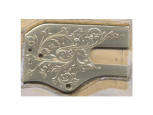
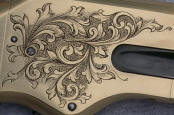
The pictured examples show modestly engraved sideplates from flint lock
Kentucky rifles. Also pictured is the sideplate of a Uberti replica of
a "66 Winchester engraved by Roger Bleile. In the first picture the
scrollwork has been outlined and the next pictures shows the completed
engraving.
|
SIGNET RINGS- Generally bearing a coat of arms, signet rings are
made by intaglio engraving, Metal signet rings can also be cast, which
is cheaper but yields a weaker material and less fine detail. Signets
are usually engraved by hand engravers who specialize in the field. A
signet is properly engraved in reverse so that when the debossed crest
or coat of arms is pressed into hot wax the resulting embossed seal is
seen in its correct orientation.
The wearing of signet rings (from Latin "signum" meaning sign) is a
longstanding tradition among nobles in European and some other
cultures. Accordingly, the engraving of signets is an ancient branch of
the engravers trade.
In contemporary usage, the signet ring is typically worn on the little
finger of either the right or left hand (depending on the country). The
ring should be worn with the seal facing outwards to enable wax
impressions without removing the ring.
Because it is used to attest the authority of its bearer, the ring has
also been seen as a symbol of his power, which is one explanation for
its inclusion in the regalia of certain monarchies. After the death of
a Pope, the destruction of his signet ring is a prescribed act clearing
the way for the sede vacancy and subsequent election of a new Pope.
Signet rings are also used as souvenir or membership attribute, e.g.
class ring (typically bear the coat of arms or crest of the school), as
an alternative to one with a stone.
The wearing of a signet ring is declining as the European aristocracy
diminishes, however noble families have upheld long standing traditions
of wearing signet rings for centuries. Sometimes the initials of the
individual are engraved into the ring if the person is not of noble
descent and does not have the right to bear [a coat of] arms.
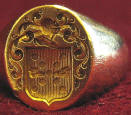
|
SMOKE PULL - A print made by one of several methods from the
engraved surface of an engraver’s work piece. Some pulls appear in
negative, by printing from the top surface, and some in positive by
drawing the ink or lampblack out of the cuts. Today this is usually
accomplished with clear packing or bookbinding tape. The engraver, as a
work record, saves these pulls. Also known as simply as a “pull” or
“smoke print.”
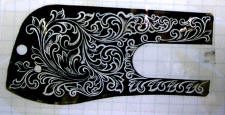
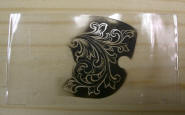
Two "smoke pulls" from the engraved sideplates of a Winchester '73
rifle are shown here.
|
SPAGHETTI ENGRAVING – See
LIBERTY
|
SQUARE GRAVER – So called because the graver blank is square in
cross section. Square gravers are ground and sharpened in such a way
that the cutting point is made from one of the 90 degree corners of the
square and the opposite corner is ground off so that the cutting face
is triangular. The square graver is one of the most commonly used
shapes and is quite versatile because it can be ground in various ways
so that the angle of the triangular cross section is anywhere from 70
to 130 degrees. The square graver should not be confused with the flat
graver whose cutting face resembles that of a wood chisel.


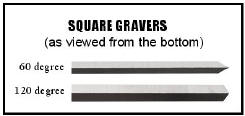
Pictured is a square graver blank, the face profile of a square graver
and a 70 degree square graver next to a 120 degree square graver as
seen from the bottom.
|
SQUARE OFF – To make square the raw end of a cut by engraving a
“pick.”
|
STEMS – Generally applied to the basic cut or fundamental part
of any letter. In block letter engraving, it refers to the vertical
cut.
|
STIPPLE or STIPPLING – A method of creating a texture on
metal using dots or circles. Stippling can be done with a single point
or circle punch, a Vibro-Graver™, or an air powered graver. Stippling
is mainly used as a background treatment for scrollwork and other forms
of leaf based ornamentation.

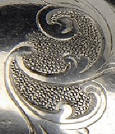

|
STITCH TOOL – A less common name for a liner or
threader. A parallel line graver.
|
STONE – A rectangular stone used by engravers to sharpen
their gravers. Also known as a bench stone.
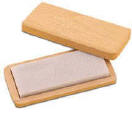

Pictured is a hard Arkansas bench stone and a diamond impregnated bench
stone with a graver mounted in a Lindsay template.
|
STONES or FINISHING STONES – Small natural or manmade
stones, either round, square, or triangular in cross section used for
shaping, smoothing, and polishing sculpted engraving in metal.
Finishing stones can be bought in a variety of grits or textures from
rough to very fine which are numbered #150 to #900 respectively.
Sometimes known as ruby stones, Scotch stones or water of Ayer.
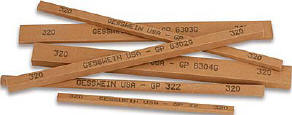
|
SUNBURST or SUNRAY MOTIF – Used as decorative space
filler, the sunburst or sunray motif was engraved by 19th century gun
engravers such as L. D. Nimschke.
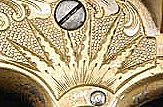
Pictured is an example of a sunburst motif engraved on an antique
revolver.
|